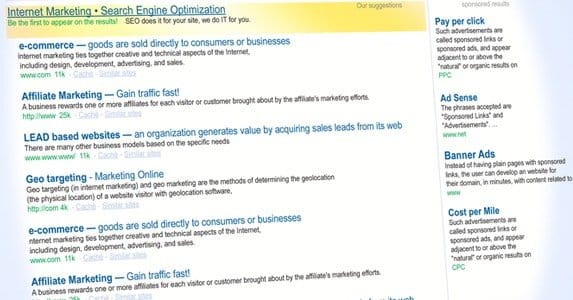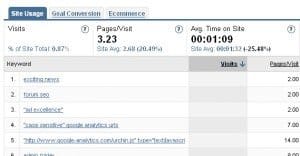The Ultimate Guide to Picking the Right Keywords for SEO

I am one of the first people to say that you really don’t need a lot of keyword attention to run a successful blog. However, I also work in the world of SEO; that means I know both the history of keywords and their relative importance in the modern world. I speak from a perspective of knowing how valuable they were years ago, and how their relevance has declined in recent years.
The Past
In the past, keywords were the basis of everything to do with SEO; keywords and links were two sides of the same coin. If you wanted a site to rank, you needed keywords, regardless of how they were used or what the quality of the content may have been.
This was because of the way Google worked. All it did, content-wise, was shred a web page to pull potential search terms. In its relative infancy, Google didn’t have qualitative judgments embedded in the algorithm. It just figured that the more times you used a keyword, the better the content would have to be relating to that keyword, so it ranked you higher.
The usage of keywords evolved with the back-and-forth of Google and black hats. Black hats would embed keywords in the code where only Google could see it; Google decided that was spammy and made it no longer work. Spammers hide keywords with background colors, Google analyzed colors and demoted sites abusing them. Spammers threw keywords in at a high density, Google demoted content with excessive keyword stuffing.
The Present
Today, Google has evolved to have significant qualitative judgment capability. It can look at a piece of content and know with reasonable certainty whether that content is good, mediocre, bad, or spam. It uses dozens of factors, ranging from the length, the formatting, and the links all the way to keyword analysis.
Modern keyword analysis involves more than just usage of a given keyword a certain number of times. In the past, webmasters would put a lot of attention into this keyword density. Today, keyword density doesn’t matter.
How do you successfully use a keyword in modern SEO? You just use it. You don’t measure it, unless you’re just paying attention to make sure you’re not over-using it. There’s no ideal keyword density, there’s no magic formula for using certain words to get Google to pick up on your content.
This article, for example, is about picking keywords. Yet you don’t see the phrases “picking keywords” or “keywords for SEO” crammed into every second paragraph, do you? Of course not. And yet, when you read – and when Google scans – you pick up on the topic.
The Future
Keywords are always going to be important. Keyword frequency is not. Keyword stuffing only exists as a trap for novice webmasters and spammers. Google is also working on semantic search, which doesn’t even parse exact match keywords, rather extracting meaning from content and extrapolating topics. When semantic search becomes dominant, there will be no more targeting minor variations in keyword usage for specific queries.
To use an example, imagine the query “cheap pizza in Chicago.” Using purely keyword-driven search analysis, Google might display anything with the word “cheap” in it, anything relating to Chicago, and anything to do with pizza.
With semantic search, Google understands what “cheap” means, and recognizes that Chicago is a location, so the query is very likely a direct question: “where can I find low-cost pizza in the Chicago area?” The results it serves, then, will be links that directly answer that question, even if they don’t use the word “cheap”, or use local keywords that identify suburbs of Chicago without mentioning Chicago itself.
Properly Using Keywords
So how, in modern SEO, do you pick and use keywords? The main thing you need to keep in mind is that you need to let your keywords guide your content. A keyword is a topic of conversation, a starting point for an article. It’s not a bit of pixie dust you need to add to every paragraph for it to work.
The second thing you need to consider is proper placement for keywords. You should have your keyword in your H1 title, in your meta title, in your meta description, and in your content. Ideally, it will only appear a couple of times in your content.
Again, semantic search comes into play. Google knows your primary keyword based on your meta usage and its presence in your title. It then breaks down your post and judges how relevant it is to that keyword.
You should also only target one keyword, and only target a given keyword once. When you try to target more than one keyword in a piece, it becomes harder to rank for any given keyword you use in the piece. You’re diluting it, effectively. Similarly, using the same keyword to rank more than one piece also dilutes it. It’s called keyword cannibalization.
Picking Keywords
Alright, enough dilly-dallying. How do you actually go about picking the right keywords for your site?
1. First, you need to be familiar with your business and what topics you’re going to be covering.
2. Second, you need to brainstorm keyword ideas. Come up with search phrases you, a user, a client, or a casual reader might use to search for what you provide. If you sell shoes, “red nike” might be a good keyword. A better keyword would be “red air Jordans” or another specific shoe.
3. Put those keywords into a tool like Google’s keyword planner or one of the may keyword research sites available. These sites will give you an idea of the search volume for a keyword, the competition for that keyword, and a list of other, similar keywords.
4. Use these keywords as the basis for content ideas. The shoe example is difficult for a blog post, but it works perfectly for a product page. A related blog post might talk about the history of Air Jordans, the various colors they come in, and other details of the product.
5. Repeat.
Yes, it’s not a very specific guide, but that’s because keyword research is more of an art than it is a science. You need the right mixture of intuition, creativity and knowledge to pick good keywords. You need to learn when a keyword has too much competition, or too little volume, to be useful. A lot of it will come with experience, and a lot of it will come down to volume. Every piece of content targets a keyword of its own; thus every piece of content is an opportunity.
 ContentPowered.com
ContentPowered.com






